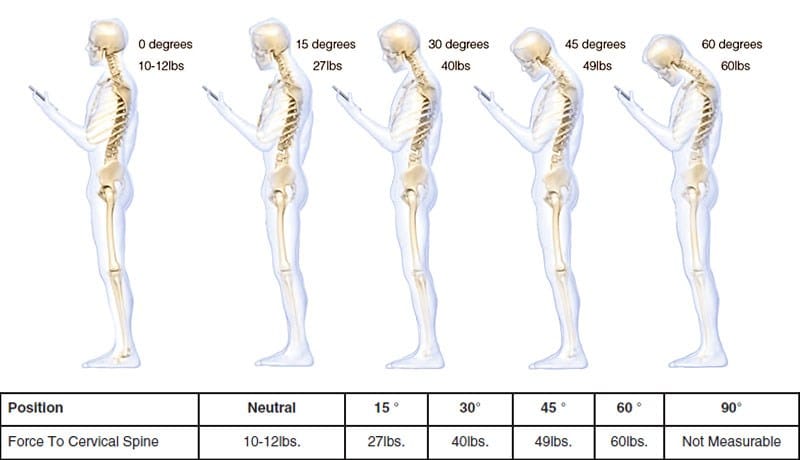We live in a time when mobile devices have become the de-facto of everyday life. Many of us check our phone several times a day, be it to message, send emails, or browse internet. Some of us watch movies or read e-books on the go. All in all, our device usage easily adds up to hours a day!
If you’re a mobile phone, tablet, or e-reader user, time to look up (literally). A new study published in the journal Surgical Technology International suggests that the typical texting and mobile surfing posture is the equivalent of placing a 60-lbs / 27-kg weight on one’s neck. Check out this computer model developed by Dr. Kenneth Hansraj, a New York spinal and orthopedic surgeon:

According to Hansraj’s results, the force exerted on our spine dramatically increases when our head flexes forward. It goes from 10-12 pounds in the neutral position (that’s the weight of an average adult human head), to 27 lbs at 15 degrees, to 40 lbs at 30 degrees, to 49 lbs at 45 degrees and 60 lbs at 60 degrees! 60 lbs — that’s 5-6 times the usual force on our neck at a neutral position — isn’t light by any means, and is the equivalent weight of a boxer dog, a punching bag, or an arm chair!![1]
Now this data wouldn’t be so alarming if not for the fact that many of us spend long periods of time on phones, tablets, and e-readers. Assuming we spend just two hours a day on mobile devices, that adds up to over 700 hours a year, meaning at least 700 hours of additional stress to our spine a year each year!
I don’t know about you, but good health is important to me, and this includes good spinal health. With back pain affecting 8 out of 10 people[2] and spinal problems starting as early as age 29[3], it’s important that we don’t take our spinal health for granted.
Here are my five recommendations on what to do instead:
- When using your phone, hold it up to chin level, as opposed to your chest or waist level. Putting it at your chest or waist level forces you to push your neck down and forward, which is where bad posture begins.
- Use a phone or tablet stand so you don’t hunch over so much when using it. Prop it up to a good height (not so low that you have to slouch).
- Bad posture from mobile usage can be due to poor readability of your devices. Increase the readability by doing these:
- Increase the default font size for your messaging apps, browser, and any app that you often use. You should be able to do this in “Settings” menu.
- Use the zoom function. This should be available in browsers, email, and PDF readers.
- Increase the brightness and contrast of your device.
- Be in a well-lit space before using your device, such as having natural light or using a desk lamp.
- Take regular breaks from phone/computer to recharge yourself.
- Do regular stretches for your neck and back. Hansraj recommends these tips:
- To keep the joints in your neck limber, move your head from left to right several times and touch your ear to your shoulder on both sides.
- Place your hands on your head to provide some resistance as you push your head forward, and do the same as your push your head back. This strengthens the ligaments and muscles that support your neck.
- When standing in a doorway, extend your arms and push your chest forward. This stretches and strengthens “the muscles of good posture.”
If you’re experiencing back pain or want to strengthen your back, here is a back-stretching tutorial for you:
Incorporate these changes with the 21-day trial: 21 Days To Cultivate Life Transforming Habits
Many incidences of back pain can be avoided — and that’s by developing a good posture from the get-go. Read: Benefits of a Good Posture (And 13 Tips to Get One)
(Image)




![Good Carbs vs. Bad Carbs [Infographic]](https://personalexcellence.co/files/infographic-good-bad-carbs-400x1100.gif)

 I hope you find my content helpful. Join my community of 65,000 readers and get my latest articles delivered to your inbox. Your email is safe and I never send spam.
I hope you find my content helpful. Join my community of 65,000 readers and get my latest articles delivered to your inbox. Your email is safe and I never send spam.
Investing in a laptop stand for my desk has been one of the best purchases I’ve made in a long time. I used to get neck and back pain from being hunched over at my desk for hours on end.
Nice post!
Great post! I’ve been concerned with my posture especially since I’ve began work in a typical office setting. I find myself often getting up and walking around just because it bothers me to sit still at my desk for so long (not to mention, it hurts my eyes after a while!) I’m about to re-read your post about good posture again as a reminder.
I really love the tips that you quoted here as well. I’ve actually been lifting my phone up higher/not lowering my head as much when I check it, so it’s great to see from this post that I had the right idea!
Hi Calae, that’s fantastic! The tips (except the sixth one on stretching tips by Hansraj) are by myself so they aren’t scientifically recommended or anything like that, but I do believe they’re a step in the right direction, in terms of helping us not to put more pressure on our spine.
One other thing I do is I try to go for a body massage every month (or two) to loosen up my muscles/joints. I’ve been missing it for the past few months, but seeing this research reminds me that I need to get back in the routine! I just went for a foot massage earlier this week and it felt great!
I’m actually also concerned about this with reading!!! Because, usually when reading, I don’t adopt the most ideal posture. And thanks for this piece of advice. I forget to exercise my eyes, sometimes, I guess: “Just because your device is not in front of your face doesn’t mean you need to tilt your head completely to read it. Your eyes have a range of motion, so use that (and minimal tilting) to read your device.”
Commenting for this post is closed.